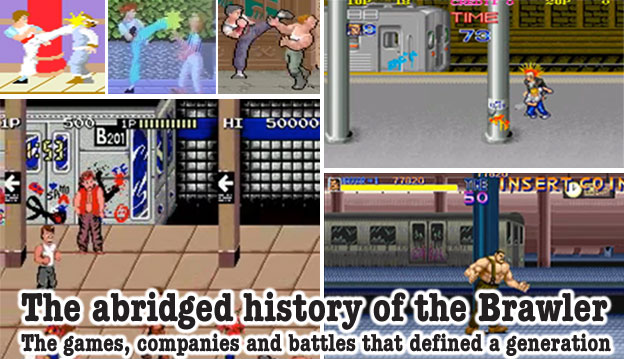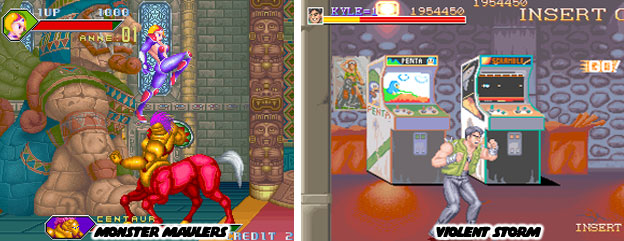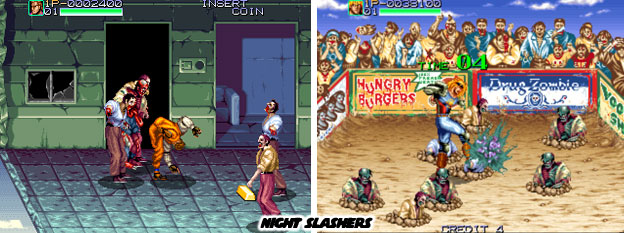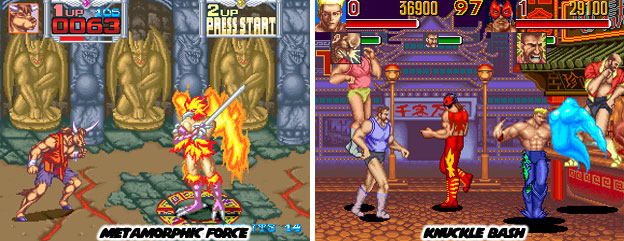
The year 1993 saw an increase in the number of brawlers released. Konami was in fine form as they continued to innovate and redefine what the genre meant. Monster Maulers was one of the first experiments between the brawler and the fighting game. The mechanics of the game were very much based on the traditional fighting game. The gameplay took plane on a 2D plane. Characters could not move into the foreground or background. Players could perform special moves on top of regular punch, kick and grapple attacks.
The only thing that made this game a brawler instead of a fighting game was in that up to two players could battle against the collection of monsters, aliens and mythological creatures on each stage. The designs were uniquely Japanese but nothing extraordinary.

Konami the turned around and released Violent Storm. It was one of the most random, poorly designed and executed brawlers they had ever released. It was hard to believe that the same people that had released the X-Men, Ninja Turtles and the Simpsons had developed this game. It was as formulaic as brawlers got with absolutely no redeeming factors.
The sprites were large, the animation rushed, the levels sparse, the opponents bland and the bosses insipid. Konami was going through the motions and releasing brawlers just because they could. The company that could previously do no wrong had a half-hearted effort wasted on arcade owners. Their hubris would cost them market share.
Even though they pioneered a lot of fight mechanics in 2D games and were responsible for inspiring the genre through Karate Champ, Data East did not have a strong history with brawlers, especially following after Captain America and the Avengers. Night Slashers made up for that. It was a dramatic, gross and violent brawler as ever there was one. It was exactly the type of game the genre lacked.
The designs were a bit over-the-top, with a suit-wearing British vampire hunter teaming up with an American rockstar-looking monster hunter with cybernetic arms and a Chinese martial artist. The premise was dramatic gold. Monsters, mutants and the undead had taken over the world, it was up to a trio of fighters to make things right. The characters had specials and super attacks at their disposal as they took on waves of zombies and other undead creatures. The gore, like the violence featured in brawlers was catering to the tastes of guy gamers.

What really set this game above the crop of brawlers were the bonus games. Players took turns playing things like zombie bowling, in which players threw zombies from 10 yards out and zombie whack-a-mole where players kicked the heads off of zombies as they popped up from holes in the sand. It was an absurd premise as audiences gathered around these zombie events, standing behind barricades emblazoned with sponsor logos like Zombie Burger and Drug Zombies. That dark humor was what Konami was missed in Violent Storm. Sadly of all the arcades I visited I only saw one dedicated cabinet. With the popularity of zombies then perhaps we might see this Data East gem come out on PSN or Xbox Live.
Capcom did not wait to see what Konami was up to next. They secured the rights to another Marvel character and released the violent Punisher title. The game was still a co-op brawler with Nick Fury filling in for player-2. Classic villains like the Kingpin were placed alongside modern villains including Jigsaw and Bushwacker.
The game retained the Capcom Japanese aesthetic rather than strict US comic book designs. The studio did, as they always had, place exaggerated muscles on their figures so they would appeal to western gamers. Other developers were often unsure of those proportions so they always went lean with their characters. The subject matter was a little more intense in order to reflect the Punisher comic books. The Punisher comics were often more mature and brutal than other superhero books. They predated the anti-heroes from the Wanted and Kick Ass graphic novels. The game itself was violent for brawler standards, when the Punisher pulled the trigger on his guns opponents went down hard.

Capcom kept the intensity up with their next comic-to-brawler. Cadillacs and Dinosaurs was an indy comic series with a small but dedicated following. The game was based more on the work from the short-lived animated series than from the comics.
The title featured the same impacting gun play from the Punisher with the great designs from the comics and animation. The best Capcom title of the year, and for that matter the best brawler of the year, was based on a license. It was neither the Punisher or Cadillacs and Dinosaurs but instead something that was previously considered the nerdiest of pursuits.
Dungeons and Dragons: Tower of Doom was based on the fantasy roleplaying system and brought over a lot of their mythology and design into the brawler. The older Capcom fantasy brawlers, including King of Dragons and Knights of the Round, seemed to have been building towards the D&D license. The oldest of the fantasy brawlers, Magic Sword was set in a castle tower as well, some 50-stories tall. It was a brutal but rewarding quarter grabber, the levels were filled with traps and monsters, it predated the Tower of Doom by years. The game did have plenty of different character classes and even a rich narrative, still it felt as if something were missing. The D&D license allowed Capcom to bring everything together.
The Tower of Doom featured a small group of character classes that player could build through collecting coins, equipment and potions from defeated opponents. Players could visit nearby towns and upgrade their equipment and restore health with recovered loot. Instead of starting with nothing on each play through the cabinet allowed players to save their progress locally.

The attention to detail, character designs, art and animation were superb to every other title released that year or any year before. The brawler with role-playing elements was a long time coming. Capcom waited to apply it into a genre that they had become exceptional at. They knew the ins and outs of the brawler, including the nuances of timing, the difficulty curve, problems with repetition and boss encounters. While the D&D subject matter was not appealing to all of the gamers, the lessons learned from its design were invaluable.
By comparison Konami was now going through the motions with each arcade release and losing more steam by the moment. It stood to reason why their best developers were starting to leave the studio and move into console development. Their last brawler of 1993 was Metamorphic Force. The game attempted to marry the fantasy elements of warriors set in a world of shape-shifting monsters. Any of the 4-players could transform into a were-animal, including were-tiger and were-bear. Unlike the clock on Sengoku the transformations here were not timed.
The concept was great. It was as if there was a brawling version of Sega's Altered Beast. It was the execution that was lacking. The quality of the designs, brightly colored levels and sparse gameplay elements felt unpolished. This title felt more lacking than even Violent Storm. It was not however the worst brawler released that year.

Atari had become aware of the popularity of the brawler. They had been losing a market share in arcades since the late 80’s to the Japanese. To try and turn things around they published their own brawler developed by a company called Toaplan. Knuckle Bash was unique in concept, introduced some new elements but ultimately had an abysmal execution.
The game was an attempt at making a narrative out wrestlers and the wrestling business. The story revolved around crooked wrestlers and crime lords tarnishing the good name of pro wrestling. The game began with one of three characters, a masked luchador, an Elvis-gimmick wrestler and a straight-shooting wrestler. Three more characters, which were at some point in the game were bosses, could be added to the lineup. The game allowed players to switch characters between levels. Adding bosses as playable characters and allowing the switch of characters between stages was a fantastic idea. Unfortunately the game was formulaic, nonsensical and had poorly designed characters and bosses. Despite the good ideas it was one of the worst brawlers ever released. 1993 was an interesting year but the brawler was steadily declining in popularity, less and less memorable titles would be released over the rest of the decade. Some of the best experiences were still to come. As always if you enjoyed this blog and would like to sponsor me please visit my Patreon page and consider donating each month, even as little as $1 would help make better blogs and even podcasts!
Even though they pioneered a lot of fight mechanics in 2D games and were responsible for inspiring the genre through Karate Champ, Data East did not have a strong history with brawlers, especially following after Captain America and the Avengers. Night Slashers made up for that. It was a dramatic, gross and violent brawler as ever there was one. It was exactly the type of game the genre lacked.
The designs were a bit over-the-top, with a suit-wearing British vampire hunter teaming up with an American rockstar-looking monster hunter with cybernetic arms and a Chinese martial artist. The premise was dramatic gold. Monsters, mutants and the undead had taken over the world, it was up to a trio of fighters to make things right. The characters had specials and super attacks at their disposal as they took on waves of zombies and other undead creatures. The gore, like the violence featured in brawlers was catering to the tastes of guy gamers.

What really set this game above the crop of brawlers were the bonus games. Players took turns playing things like zombie bowling, in which players threw zombies from 10 yards out and zombie whack-a-mole where players kicked the heads off of zombies as they popped up from holes in the sand. It was an absurd premise as audiences gathered around these zombie events, standing behind barricades emblazoned with sponsor logos like Zombie Burger and Drug Zombies. That dark humor was what Konami was missed in Violent Storm. Sadly of all the arcades I visited I only saw one dedicated cabinet. With the popularity of zombies then perhaps we might see this Data East gem come out on PSN or Xbox Live.
Capcom did not wait to see what Konami was up to next. They secured the rights to another Marvel character and released the violent Punisher title. The game was still a co-op brawler with Nick Fury filling in for player-2. Classic villains like the Kingpin were placed alongside modern villains including Jigsaw and Bushwacker.
The game retained the Capcom Japanese aesthetic rather than strict US comic book designs. The studio did, as they always had, place exaggerated muscles on their figures so they would appeal to western gamers. Other developers were often unsure of those proportions so they always went lean with their characters. The subject matter was a little more intense in order to reflect the Punisher comic books. The Punisher comics were often more mature and brutal than other superhero books. They predated the anti-heroes from the Wanted and Kick Ass graphic novels. The game itself was violent for brawler standards, when the Punisher pulled the trigger on his guns opponents went down hard.

Capcom kept the intensity up with their next comic-to-brawler. Cadillacs and Dinosaurs was an indy comic series with a small but dedicated following. The game was based more on the work from the short-lived animated series than from the comics.
The title featured the same impacting gun play from the Punisher with the great designs from the comics and animation. The best Capcom title of the year, and for that matter the best brawler of the year, was based on a license. It was neither the Punisher or Cadillacs and Dinosaurs but instead something that was previously considered the nerdiest of pursuits.
Dungeons and Dragons: Tower of Doom was based on the fantasy roleplaying system and brought over a lot of their mythology and design into the brawler. The older Capcom fantasy brawlers, including King of Dragons and Knights of the Round, seemed to have been building towards the D&D license. The oldest of the fantasy brawlers, Magic Sword was set in a castle tower as well, some 50-stories tall. It was a brutal but rewarding quarter grabber, the levels were filled with traps and monsters, it predated the Tower of Doom by years. The game did have plenty of different character classes and even a rich narrative, still it felt as if something were missing. The D&D license allowed Capcom to bring everything together.
The Tower of Doom featured a small group of character classes that player could build through collecting coins, equipment and potions from defeated opponents. Players could visit nearby towns and upgrade their equipment and restore health with recovered loot. Instead of starting with nothing on each play through the cabinet allowed players to save their progress locally.

The attention to detail, character designs, art and animation were superb to every other title released that year or any year before. The brawler with role-playing elements was a long time coming. Capcom waited to apply it into a genre that they had become exceptional at. They knew the ins and outs of the brawler, including the nuances of timing, the difficulty curve, problems with repetition and boss encounters. While the D&D subject matter was not appealing to all of the gamers, the lessons learned from its design were invaluable.
By comparison Konami was now going through the motions with each arcade release and losing more steam by the moment. It stood to reason why their best developers were starting to leave the studio and move into console development. Their last brawler of 1993 was Metamorphic Force. The game attempted to marry the fantasy elements of warriors set in a world of shape-shifting monsters. Any of the 4-players could transform into a were-animal, including were-tiger and were-bear. Unlike the clock on Sengoku the transformations here were not timed.
The concept was great. It was as if there was a brawling version of Sega's Altered Beast. It was the execution that was lacking. The quality of the designs, brightly colored levels and sparse gameplay elements felt unpolished. This title felt more lacking than even Violent Storm. It was not however the worst brawler released that year.

Atari had become aware of the popularity of the brawler. They had been losing a market share in arcades since the late 80’s to the Japanese. To try and turn things around they published their own brawler developed by a company called Toaplan. Knuckle Bash was unique in concept, introduced some new elements but ultimately had an abysmal execution.
The game was an attempt at making a narrative out wrestlers and the wrestling business. The story revolved around crooked wrestlers and crime lords tarnishing the good name of pro wrestling. The game began with one of three characters, a masked luchador, an Elvis-gimmick wrestler and a straight-shooting wrestler. Three more characters, which were at some point in the game were bosses, could be added to the lineup. The game allowed players to switch characters between levels. Adding bosses as playable characters and allowing the switch of characters between stages was a fantastic idea. Unfortunately the game was formulaic, nonsensical and had poorly designed characters and bosses. Despite the good ideas it was one of the worst brawlers ever released. 1993 was an interesting year but the brawler was steadily declining in popularity, less and less memorable titles would be released over the rest of the decade. Some of the best experiences were still to come. As always if you enjoyed this blog and would like to sponsor me please visit my Patreon page and consider donating each month, even as little as $1 would help make better blogs and even podcasts!

No comments:
Post a Comment